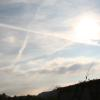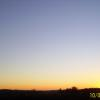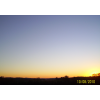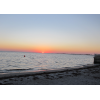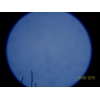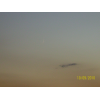Visibility of Dhul Qeadah Crescent 1431 AH
- When to Observe Dhul Qeadah Waxing (NEW) Crescent ?
- Dhul Qeadah Waxing (NEW) Crescent Observation Results
- The OFFICIAL First Day in Different Countries
- When to Observe Shawwal Waning (OLD) Crescent ?
- Shawwal Waning (OLD) Crescent Observation Results
When to Observe Dhul Qeadah Waxing (NEW) Crescent ?
The geocentric conjunction (Geocentric New Moon) will occur Inshalla on (Thursday 07 October 2010) at 18:44 UT.
Sighting the new crescent on (Thursday 07 October 2010) and (Friday 08 October 2010) is shown in the below graphs using the program Accurate Times by Mohammad Odeh according to Odeh criterion. Where:-
- It is impossible to see the crescent from the areas located under the red color. Because either the Moon on this day sets before the Sunset and/or the topocentric conjunction occurs after the Sunset.
- The crescent is expected to be seen by optical aid only from the areas located under the blue color.
- The crescent is expected to be seen by optical aid from the areas located under the magenta color. In these areas the crescent could be seen by naked eye if the atmospheric conditions are superb and the observer is experienced.
- The crescent is expected to be easily visible by naked eye from the areas located under the green color.
- The crescent cannot be seen from uncolored areas, even though the Moon sets in these locations after the Sunset and the topocentric conjunction occurs before the Sunset, but the Moon is not sufficiently illuminated in order to be seen as crescent even by optical aid.
- Kindly notice that the below graph shows the possibility of seeing the crescent from areas between 60 degrees north of Equator down to 60 degrees south of Equator.
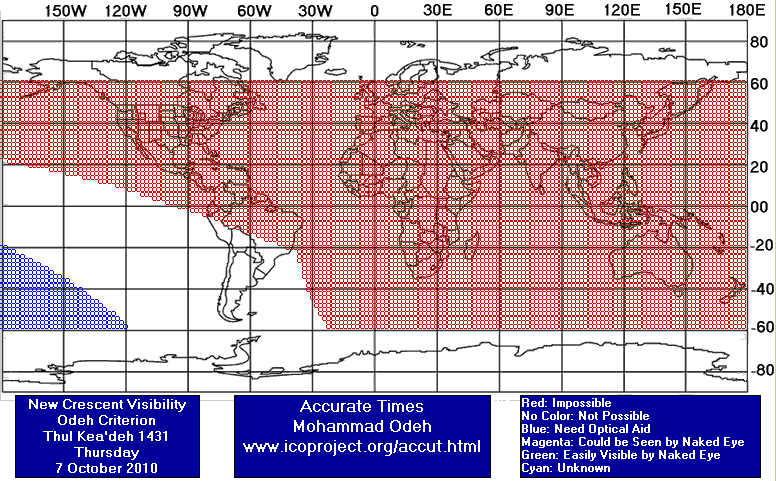
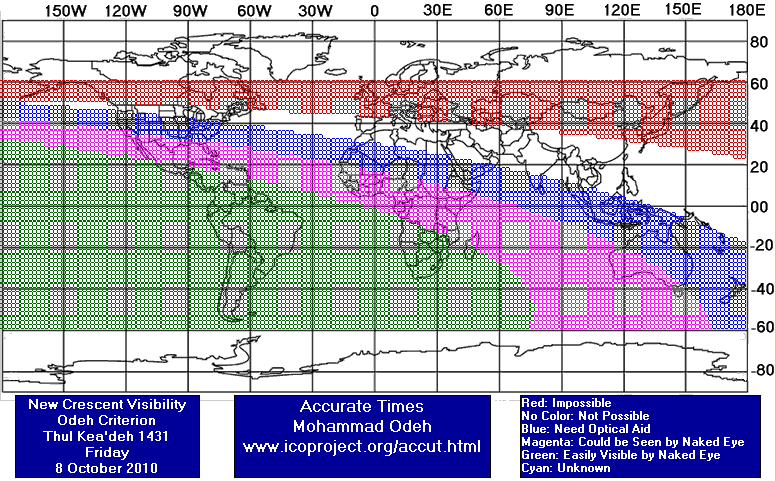
According to the Universal Hejric Calendar (UHC), which is based on the calculated crescent visibility, the start of this month in the Eastern Region will be on Saturday 09 October 2010 and in the Western Region will be on Saturday 09 October 2010. Kindly notice that the UHC is a pre-calculated calendar, which adopts a certain criterion to start the new Hejric month. Your country/organization might adopt different criterion to start the new Hejric month. So it is highly advised to read the UHC website before giving any judgment.
- Results of seeing the crescent, and the first day of the month in different countries will be added here Inshalla as we receive the reports from ICOP's members. If you wish to be a member in ICOP, or to know more about it, kindly click here.
Dhul Qeadah Waxing (NEW) Crescent Observation Results
Fri 08 October 2010
Germany
Eng. Martin Elsaesser said: "The autumn fog only lifted two hours after noon and the skies remained hazy with cirrus clouds in several layers. I could capture the crescent with the established contrast enhancement technique and follow it for several hours till it dropped behind the trees, some 4° above the horizon. The bad sky conditions prevented capturing more detailed images. The last observation happened about 40 minutes before moonset, with the moon setting some 8 minutes before the sun. "
Nigeria
Mr. Simwal Jibril said: "The western horizon was totally cloudy."
Norway
Mr. Milad Ali Ershaghi said: "On Friday, October 8, 2010, sunset time in Oslo, Norway was 6:30pm and moonset time was 5:52pm. So it was not astronomically possible to see the moon. I tried to look for it anyhow after sunset - but did not see the moon."
Oman
Prof. Mohammed Al-Bussaidi said: "The crescent Moon was at very low altitude and combination with hazy and clouds on the western sky, made sighting for the Dhu LQa'adah 1431 not possible from Muscat, Oman on this day."
Pakistan
Mr. Alam Sultan said: "Today ( Friday, 08 October 2010 = Pakistan: 28 Shawwal 1431 / Saudi Arabia 29 Shawwal), on my request, nearly 30 persons ( members of the moon-sighting committees of our institute "JAMIA-TUR-RASHEED" + my friends + their companions) tried to sight the moon all over Pakistan at more than 11 places but the moon could not be sighted, as it was astronomically expected tonight. Almost it was clear all over the country. Note 1: Today :( Friday, 08 October 2010 = Pakistan: 28 Shawwal 1431 / Saudi Arabia 29 Shawwal), the conditions of the moon were so defective in many parts of the world specially in whole Asia that according to the all old and new criteria of moon-sighting, there was no solid proof in the history of astronomy to sight such a moon by naked eyes in Pakistan. Moreover, it was 28th Shawwal in Pakistan, therefore there was no need to try to sight the moon in Pakistan, but in spite of these facts, to increase the trust of common people in the Science of Moon-sighting and because the people were confused due to the 29th shawwal in Saudi Arabia, I requested our members to sight the moon today. Note 2: After some days, inshaallah, a detailed report of this observation will be available in Urdu at www.esnips.com/web/moonnewsofjamiaturrasheed "
Saudi Arabia
Mr. Saleh Al-Saab said: "The crescent was only (1.5) degrees above the horizon at sunset only."
South Africa
Dr. Abdurrazak Ebrahim said: "From my sighting station at the Greenpoint lighthouse at sea level I sighted the thin crescent per 20x50 binoculars at 19h15 local time before it slipped behind a bank of clouds. At 19h19 I received a call via mobile from experienced observers that the crescent was sighted by naked-eye from Signal Hill [360 m elevation]. Positive sighting reports were also received from Johannesburg."
Tanzania
Mr. Zaffar Sheriff said: "A fair elongation of 12deg, resulting in illumination of 1.2%. However the low crescent altitude of 8.3deg was low for this hazy evening. Cresent was not seen in Daresslaam"
United Kingdom
Eng. Qamar Uddin said: "On Friday 8 October 2010 (29 Shawwal 1431 AH) many people from UK including York have attempted to sight the crescent moon (Hilal) of Dhul Qaidah after sunset. Most places were cloudy so none of the groups were able to sight the Hilal. However, we have received reliable sighting news (Muhaqaq Ruyat-e-Basari) from South Africa. Therefore, the Ulama in UK have decided that the month of Shawwal 1431 AH will have 29 days and the month of Dhul Qaidah 1431 AH will start from Saturday 9 October 2010, Insha-Allah."
United States
Dr. Javad Torabinejad said: "My wife, daughter, and I using a pair of binoculars (7X50) were able to sight a very thin crescent in Blacksburg, VA. The first binocular sighting was at 1:55 pm (sunset 6:54 pm EDT; moonset 7:11 pm). My last sighting was at 4:25 pm. To find the moon's location, I used the Sky & Telescope Interactive Sky Chart. Venus which was first observed at 1:06 pm helped me in locating the moon. The crescent was about 12 degrees to the lower left of the sun (the sun was blocked by our house). The horns were at about 12:30 and 3:00 O'clock (12:30;2:00;3:00). I was unable to sight the crescent with naked eye, however. The sky was clear. This evening, I also tried sighting the moon in Blacksburg, with no success. Soon after arriving at my sighting location, I searched for Venus which was observed first by a pair of binoculars (7X50) followed by naked eye sighting at 6:36 pm (sunset 6:54 pm EDT). Then, I started scanning the west southwest horizon for the moon. I continued this till past moonset (moonset 7:11 pm). The horizon was clear with some haze."
Dr. Hussain Dashti said: "Salam Alaikom, Today, Friday the 8th of October 2010, I went to sight the Hilal in Clearwater, Florida. I was able to sight it with my 10X50 binocular only. The crescent's calculations were: - Sunset: 19:08 LT T. Moon Age: +28H 10M - Moonset: 19:37 LT Moon Lag Time: +00H 29M T. Moon Altitude: +04°:57':38" T. Elongation: +16°:40':21" T. Relative Azimuth: -15°:38':57" T. Crescent Width: +00°:00':42" T. Illumination: 02.11 % The actual sunset was at 19:08. The hilal was first sighted by binocular at 19:17, and was last sighted by binocular at 19:31. This is the first time for me to sight a Hilal with a lag time of 29 minutes. The clear sky is shown in the attached photo. Thanks Dr. Hussain Dashti Clearwater, Florida"
Dr. John Caldwell said: "excellent conditions, seen from 1941, clearly seen from 1945, blocked by distant peak from 1950, only "glimpsed" not "seen" for about 2 minutes before 1941, seeing before 1945 needed binocular pointing as location aid, venus confirmed pointing system, easily seen in binoculars on first try (1933) so no doubt could have found it earlier in binoculars had I tried; visually 1941-1944: seeing at limit of "real seeing", 1945-1949: clearly seeing but never "easy" seeing"
Sat 09 October 2010
Pakistan
Mr. Alam Sultan said: "Not seen by me due to clouds / Easily seen by others countrywide: On my request, Today (Saturday 09 October 2010 = 29 shawwal 1431 in Pakistan) many hundred persons (Members of the moon-sighting committees of our institute "JAMIA-TUR-RASHEED" + my friends + their companions) tried to sight the moon all over Pakistan and resultantly as it was expected astronomically, nearly 300 persons easily sighted the crescent at more than 13 places in 3 provinces (Sindh, Balochistan and Punjab). Many places were cloudy therefore moon was not sighted there. It was almost clear in Khyber-pakhtoon-khawa but the moon was not sighted there, whilst it was 30th day as per their provincial announcement of shawwal. Note 1 : Chairman of central official moon sighting committee of Pakistan, mufti Munee-bur-Rahman told me on my mobile phone that after receiving the positive reports, he officially announced that 1st Zul-Qa'dah 1431 will be on Sunday 10th October 2010 in Pakistan after ending the 29 days of Shawwal 1431. Note 2: After some days, inshaallah, a detailed report of this observation will be available at www.esnips.com/web/moonnewsofjamiaturrasheed "
United States
Dr. Javad Torabinejad said: "Today (Saturday, October 09, 2010), my daughter, and I were able to sight the moon in Blacksburg, VA. My first binocular sighting was around 11:23 am (sunset 6:53 pm EDT; moonset 7:53 pm); naked eye sighting was not possible then. I tried sighting again in the afternoon and was able to see the crescent by naked eye at 2:01 pm. To find the moon location, I used the Sky & Telescope Interactive Sky Chart. The horns were at 11:30 and 3:30 O'clock (11:30;2:00;3:30). In the evening, my daughter and I arrived at our sighting location prior to sunset. Using a pair of binoculars, I started looking for the crescent and was able to located it at 6:37 pm followed by naked eye sighting. My daughter also was able to see it by naked eye. At 6:52 pm, the crescent was about 9 degrees above the horizon. At 6:53 pm, the horns were at 1:30 and 6:00 O'clock (1:30;3:30;6:00). The sky was mostly clear and hazy."
The OFFICIAL First Day in Different Countries
Fri 08 October 2010
1 . Libya
Sat 09 October 2010
1 . Algeria
2 . Bahrain
3 . Egypt
4 . Jordan
5 . Kuwait
6 . Lebanon
7 . Nigeria
8 . Norway
9 . Palestine
10 . Qatar
11 . South Africa
12 . Syria
13 . United Arab Emirates
14 . United Kingdom
Sun 10 October 2010
1 . Morocco
2 . Oman
3 . Pakistan
4 . Saudi Arabia
When to Observe Shawwal Waning (OLD) Crescent ?
The geocentric conjunction (Geocentric New Moon) will occur Inshalla on (Thursday 07 October 2010) at 18:44 UT.
Sighting the OLD crescent on (Thursday 07 October 2010) and on (Wednesday 06 October 2010) is shown in the below graphs using the program Accurate Times by Mohammad Odeh according to Odeh criterion. Where:-
- It is impossible to see the OLD crescent from the areas located under the red color. Because either the Moon on this day rises after the Sunrise and/or the topocentric conjunction occurs before the Sunrise.
- The crescent is expected to be seen by optical aid only from the areas located under the blue color.
- The crescent is expected to be seen by optical aid from the areas located under the magenta color.. In these areas the crescent could be seen by naked eye if the atmospheric conditions are superb and the observer is experienced.
- The crescent is expected to be easily visible by naked eye from the areas located under the green color.
- The crescent cannot be seen from uncolored areas, even though the Moon rises in these locations before the Sunrise and the topocentric conjunction occurs after the Sunrise, but the Moon is not sufficiently illuminated in order to be seen as crescent even by optical aid.
- Kindly notice that the below graph shows the possibility of seeing the crescent from areas between 60 degrees north of Equator down to 60 degrees south of Equator.


Shawwal Waning (OLD) Crescent Observation Results
Wed 06 October 2010
United Kingdom
Eng. Qamar Uddin said: "On Wednesday 6 October 2010 morning before sunrise, I have tried to sight the last waning (old) crescent of Shawwal 1431 AH from York (UK). Unfortunately the sky was totally cloudy. Friends from other cities, including London have informed me, that it was cloudy and raining there too, hence the waning crescent was not sighted there, either."
